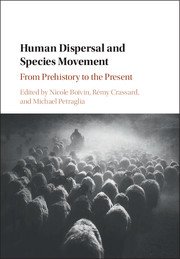Book contents
- Frontmatter
- Contents
- List of text boxes
- List of figures
- List of tables
- List of contributors
- Preface
- I Introduction
- II Origins: Species Movements in the Pleistocene
- 2 Carnivore guilds and the impact of hominin dispersals
- 3 Pleistocene hominin dispersals, naïve faunas and social networks
- 4 Hominins on the move: An assessment of anthropogenic shaping of environments in the Palaeolithic
- 5 Reconceptualising the palaeozoogeography of the Sahara and the dispersal of early modern humans
- III Across the water: Species movements by Coast and Sea
- IV Complexity: Species Movements in the Holocene
- V Invasion: The Movement of Invasive and Disease Species
- Index
- Plate section
- References
2 - Carnivore guilds and the impact of hominin dispersals
from II - Origins: Species Movements in the Pleistocene
Published online by Cambridge University Press: 04 May 2017
- Frontmatter
- Contents
- List of text boxes
- List of figures
- List of tables
- List of contributors
- Preface
- I Introduction
- II Origins: Species Movements in the Pleistocene
- 2 Carnivore guilds and the impact of hominin dispersals
- 3 Pleistocene hominin dispersals, naïve faunas and social networks
- 4 Hominins on the move: An assessment of anthropogenic shaping of environments in the Palaeolithic
- 5 Reconceptualising the palaeozoogeography of the Sahara and the dispersal of early modern humans
- III Across the water: Species movements by Coast and Sea
- IV Complexity: Species Movements in the Holocene
- V Invasion: The Movement of Invasive and Disease Species
- Index
- Plate section
- References
Summary
Abstract
The ecological impact that our species has today on other carnivorous species can be traced back to long before the origins of Homo sapiens. Carnivorans have had a great impact on hominin behavior, ecology, and evolution due to the complexity of our ecological interrelationships. This chapter examines the possible ecological impacts that hominins had on carnivorans and vice versa through time, with a focus on eastern Africa and southern Europe due to the large number of studies of those regions. Changes in hominin behavior and ecology and successive waves of hominin dispersals out of Africa occurred, but not all had the same impact on carnivorans. At various times in both Africa and Eurasia, the extinction of larger carnivorans may have provided niche space that dispersing hominins could expand into. At other times, hominins may have played a role in local extinctions. Climate change or instability also played an important role in the evolution, extinction, and dispersal of hominin and carnivoran species. In both Africa and Eurasia, carnivoran generalists fared better than specialists. Carnivoran populations may have survived in Africa because they evolved alongside Homo sapiens while their conspecifics and congeners in Eurasia went extinct after the arrival of Homo sapiens in those areas.
Keywords: Carnivore guild structure, Carnivora, hominin dispersal, extinction, hominin dietary behavior, human–carnivore interactions
INTRODUCTION
Humans and carnivores have had a long, eventful, and intertwined history. Since our lineage split from that of chimpanzees, modern humans and our ancestors have been both prey and competitors, impacting other carnivores directly and indirectly via our actions. As such, studying our place within the carnivore guild today and in the past is critical for understanding not only how we came to be, but also why we see so few carnivores today, even in areas that seem to the untrained eye to be vast, pristine, or semipristine wilderness. As noted in the Introduction to this volume by Boivin, there is ample evidence that even the most seemingly pristine regions of the world have been altered or even managed by Homo sapiens for thousands of years. For simplicity's sake, this chapter will be restricted to an examination of the mammalian portion of the carnivore guild. To distinguish between carnivorous mammals in general and members of the order Carnivora, the terms “carnivore” and “carnivoran” will be used, respectively. (See Text Box 2.1 for a glossary of additional terms used in this chapter.)
- Type
- Chapter
- Information
- Human Dispersal and Species MovementFrom Prehistory to the Present, pp. 29 - 61Publisher: Cambridge University PressPrint publication year: 2017
References
- 5
- Cited by



